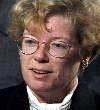The Steady-State UniverseIn conclusion I would like to return to a point glossed over earlier. I invited you to run the cosmic movie backward and mentally envision the resulting “first” moment of supremely high density as the Big Bang. This was convenient but dishonest - expansion by itself does not imply a Big Bang. To see this, consider an exponentially expanding universe shrinking backwards into the past. Such a universe shrinks by the same factor, let us say 2, for every tick of the clock. It gets continually smaller and denser but never reaches zero radius - like Xeno's runner, it never gets to the finish line in a finite time. The Big Bang of this Universe has been pushed infinitely far into the past. Such an exponential expansion is the basis of
the non-evolving, mathematically elegant steady-state model (SSM) of the
Universe by Bondi, Gold, Hoyle, Burbidge, and Narlikar. We still need to deal with the right side, which expresses the GR source terms for the gravitational field. In the classic steady-state model, gravity comes only from ordinary matter, which becomes more dilute with the expansion. If this were uncompensated, gravity would weaken, negating the notion of a steady state. Matter must therefore be spontaneously created from empty space to maintain gravity constant. The proponents of the model suggested that this occurred via the appearance of protons, at a rate just adequate to keep the average density of matter constant in time. In practice, matter must be created at a rate of about 1 atom of hydrogen per century in a volume equal to the Empire State Building. It is imagined then to collect into galaxies, where it forms stars in the usual way. Statistically speaking, a steady-state universe presents the same face to observers over all time. There is no Big Bang; the Universe existed infinitely far into the past and will exist infinitely far into the future. Galaxies expand out of a given volume, to be replaced by young galaxies newly formed from matter spontaneously generated within the same volume. Galaxies in any one place have a mixture of ages, the typical value being near the expansion age 1/Ho (a few billion years), with a long tail to much older ages.In the classic steady-state model, the only radiation is emitted by galaxies: principally by stars, interstellar dust heated by stars, and the active nuclei of Seyfert galaxies, quasars, and radio galaxies. SSM was being unhorsed when I was in graduate school, and my fellow graduate students and I enjoyed kicking it while it was down. Many data can be brought to bear against the conventional steady-state model, among which I will mention three favorites: 1) SSM does not easily account for the high helium abundance of the Universe, some 25% by mass (see above). The problem is that the abundance of elements heavier than He is much smaller, only 1% by mass. If He and heavier elements were co-produced together in stars, we should either have ten times less He or ten times more heavy elements. This problem is solved in the Big Bang picture by making He via primordial nucleosynthesis when the Universe was about 100 seconds old; the steady-state model has no such easy mechanism. 2) Classic SSM says that each volume of the Universe is statistically unchanging over time. It therefore predicts that all volumes should look the same, including those seen far away and back in time. In the 1960's, there was already strong evidence that quasars and radio galaxies were more frequent at large distances and earlier times (see above), and this was sufficient to sink the SSM in most astronomers' opinion. Such evidence has now become incontrovertible from HST - the Hubble Deep-Field fly-through shows clearly the changes in (and ultimate disappearance of) galaxies at sufficiently early eras. The appearance and numbers of distant galaxies from HST are generally quite consistent with predictions from the BB hierarchical-clustering theory for galaxy formation - but are highly inconsistent with the classic steady-state model. 3)
Finally, classic SSM cannot easily account for the precisely thermal
spectrum of the cosmic microwave background (CMB). As noted, the preponderant sources of radiation in the SSM are a
mixture of stars, hot galactic dust, and active galactic nuclei such as QSOs. These do not combine naturally to make a
purely thermal spectrum at a single temperature. A recent drastic alteration of the SSM model
by Burbidge, Hoyle, and Narlikar
Contributed by: Dr. Sandra Faber |
|
Source: Sandra Faber Related Media:
Other Resources:
|




